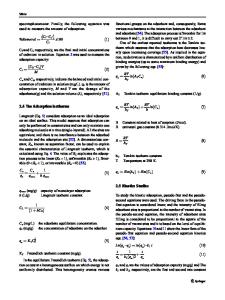Adsorptive removal of Sr 2+ and Cs + from aqueous solution by capacitive deionization
- PDF / 1,754,155 Bytes
- 14 Pages / 595.276 x 790.866 pts Page_size
- 24 Downloads / 327 Views
RESEARCH ARTICLE
Adsorptive removal of Sr2+ and Cs+ from aqueous solution by capacitive deionization Xiaojing Liu 1 & Jianlong Wang 1,2 Received: 1 July 2020 / Accepted: 31 August 2020 # Springer-Verlag GmbH Germany, part of Springer Nature 2020
Abstract The electro-assisted adsorptive removal of Sr2+ and Cs+ ions from aqueous solution by capacitive deionization (CDI) was studied using activated carbon cloth (ACC) as electrode. Various influencing factors, including initial concentration and the applied voltage, on the removal efficiency of Sr2+ and Cs+ were examined. The results showed that ACC electrode had a large amount of oxygen- and nitrogen-containing functional groups. The removal efficiency of Sr2+ and Cs+ was 40.58% and 62.05%, respectively, which decreased when their initial concentration increased from 3 to 20 mg L−1. The removal efficiency of Sr2+ and Cs+ increased by 26.64% and 17.84% with increase of the applied voltage. CDI process is favorable to remove high valence ions due to the ion-exchange and charge interaction mechanisms. The mixed-order (MO) model could fit the adsorption kinetics of Sr2+ and Cs+ (R2 = 0.938). The Redlich-Peterson isotherm could be used for Sr2+ and Cs+ adsorption. After adsorption, Sr and Cs partly deposited on the surface of the ACC, which did not change the surface structure of the ACC electrode. Keywords Capacitive deionization . Adsorption . Sr2+ . Cs+ . Kinetic model
Introduction The radioactive wastes are mainly produced from nuclear power plants, hospitals, and research activities (Mu et al. 2017), especially the radioactive wastewater that originated from nuclear reactors that received increasing attention (Al Attar et al. 2018). In addition, nuclear accidents, such as Chernobyl in 1986 and Fukushima in 2011, released large amount of radioactive waste into the environment (Al Attar et al. 2018), which posed serious threat to human health and environment due to their long half-lives, strong radiation toxicity, high solubility, and easy assimilation by organisms (Ma et al. 2017; Al Attar et al. 2018). Among the radionuclides, the strontium (90Sr) and cesium (137Cs) are the most representative radionuclide of fission products. 90Sr is the beta emission and its half-life is more than 28 years (Chen and Wang 2012; Responsible editor: Tito Roberto Cadaval Jr * Jianlong Wang [email protected] 1
Laboratory of Environmental Technology, INET, Tsinghua University, Beijing 100084, People’s Republic of China
2
Beijing Key Laboratory of Radioactive Waste Treatment, INET, Tsinghua University, Beijing 100084, People’s Republic of China
Ma et al. 2017). 137Cs is a beta/gamma emission with a longer half-life for 30 years. These two radionuclides contribute main radioactivity and heat burden (radiation), which hinder the long-term storage of nuclear waste (Chen and Wang 2016; Wang et al. 2018; Hu et al. 2019). Therefore, the removal of Sr2+ and Cs+ from aqueous solution is crucial to the safe disposal of nuclear radioactive waste. Several technologies, including chemical
Data Loading...











